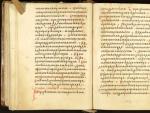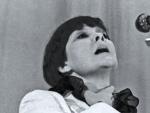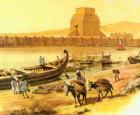Metaphor Wiktionary. Metaphor as a type of figurative meaning
from Greek metaphora - transfer, image) - the use of a word in a figurative meaning based on the similarity in any respect of two objects or phenomena; replacing an ordinary expression with a figurative one (for example, golden autumn, the sound of waves, an airplane wing).
Excellent definition
Incomplete definition ↓
METAPHOR
from Greek metaphora - transfer) - a trope (see tropes) of a word, which consists in transferring the properties of one object, process or phenomenon to another on the basis of their similarity in some respect or contrast. Aristotle in “Poetics” noted that M. is “an unusual name, transferred from genus to species, or from species to genus, or from species to species, or by analogy.” Of the four kinds of M., Aristotle wrote, in Rhetoric the M. based on analogy deserve the greatest attention, for example: “Pericles spoke of youth killed in war as the destruction of spring among the seasons.” Aristotle considers M. action to be especially strong, that is, one where the analogy is based on the representation of the inanimate as animate, depicting everything as moving and living. And Aristotle considers Homer to be an example of the use of such metals: “The bitter sting of the arrow... bounced back from the copper. A sharp arrow rushed into the midst of the enemies, towards the intended greedy victim” (Iliad). But how, with the help of M., the actions of B.L. Pasternak creates the image of a cloud: “When a huge purple cloud, standing on the edge of the road, silenced the grasshoppers that were sultryly crackling in the grass, and the drums in the camps sighed and trembled, the earth grew dark in the eyes and there was no life in the world... The cloud looked over look at the low, baked stubble. They stretched all the way to the horizon. The cloud easily reared up. They extended further, beyond the camps. The cloud settled on its front legs and, smoothly crossing the road, silently crawled along the fourth rail of the siding” (Airways). When creating M., according to Quintilian (compendium “Twelve Books of Rhetorical Instructions”), the most typical will be the following four cases: 1) replacement (transfer of property) of one animate object with another animate one (today we can talk about the transfer of property from living to living, because The Greeks and Romans considered only people to be animate). For example: “There were horses - not horses, tigers” (E. Zamyatin. Rus'); the walrus “... rolls up onto the platform again, on its fat, powerful body Nietzsche’s mustachioed, bristly head with a smooth forehead appears” (V. Khlebnikov. Menagerie); 2) one inanimate object is replaced (property transfer occurs) with another inanimate object. For example: “A river swirls in the desert fog” (A. Pushkin. Window); “Above him is a golden ray of sun” (M. Lermontov. Sail); “A rusty leaf fell from the trees” (F. Tyutchev. N.I. Krolyu); “The boiling sea below us” (song “Varyag”); 3) replacement (transfer of properties) of an inanimate object with an animate one. For example: “The word is the greatest ruler: it looks small and imperceptible, but does wonderful things - it can stop fear and ward off sadness, cause joy, increase pity” (Gorgias. Praise to Elena); “The night is quiet, the desert listens to God, and star speaks to star” (M. Lermontov. I go out alone on the road...); “A rusty bolt will cry at the gate” (A. Bely. Jester); “Bright Kolomna, hugging my sister Ryazan, wets my bare feet in the tear-stained Oka” (N. Klyuev. Devastation); “The linden trees were chilled to the bones” (N. Klyuev. The linden trees were chilled to the bones...); 4) replacement (transfer of properties) of an animate object with an inanimate one. For example: “Strong heart” (i.e., stingy, cruel) - the officer says about the moneylender Sanjuelo (R. Lesage. The Adventures of Gil Blas from San Tillana); “The Sophists are poisonous shoots that cling to healthy plants, hemlock in a virgin forest” (V. Hugo. Les Misérables); “The Sophists are lush, magnificent flowers of the rich Greek spirit” (A. Herzen. Letters on the study of nature). Aristotle in “Rhetoric” emphasized that M. “has a high degree of clarity, pleasantness and a sign of novelty.” It was M., he believed, along with the commonly used words of his native language, that are the only material useful for the style of prose speech. M. is very close to comparison, but there is also a difference between them. M. is a rhetorical trope, the transfer of the properties of one object or phenomenon to another on the basis of their similarity in some respect, and comparison is a logical technique similar to the definition of a concept, a figurative expression in which the depicted phenomenon is likened to another. Usually comparison is expressed using the words like, like, as if. M., in contrast to comparison, has greater expression. The means of language make it possible to separate comparison and M. quite strictly. This was done back in Aristotle’s Rhetoric. Here are comparisons by I. Annensky in “The Trefoil of Temptation”: “A cheerful day is burning... Among the withered grasses, all the poppies are spotted - like greedy impotence, like lips full of temptation and poison, like scarlet butterflies with unfurled wings.” They can easily be turned into a metaphor: Poppies are scarlet butterflies with unfolded wings. Demetrius, in his work “On Style,” considered another aspect of the relationship between M. and comparison. If M., he wrote, seems too dangerous, then it is easy to turn it into a comparison, inserting it, as it were, and then the impression of riskiness characteristic of M. will weaken. In the treatises of rhetoricians, in the works of specialists in the field of poetics and stylistics, most attention is paid to M himself. Quintilian called it the most common and beautiful of the tropes of rhetoric. It is, the Roman rhetorician believed, something innate and even in complete ignoramuses it often breaks out in the most natural way. But it’s much nicer and more beautiful when M. tastefully sought out and in high speech shines with its own light. It increases the richness of the language by changing or borrowing everything that is lacking in it. M. is used to amaze the mind, to more strongly identify the subject and to present it, as it were, before the eyes of the listeners. Of course, one cannot exaggerate her role. Quintilian noted that excess M. bothers the listener’s attention and turns speech into an allegory and a riddle. You should not use low and indecent M., as well as M. based on false similarity. Aristotle saw one of the reasons for the pompousness and coldness of a speaker’s speech in the use of inappropriate words. He believed that three types of words should not be used: 1) having a funny meaning; 2) the meaning of which is too solemn and tragic; 3) borrowed from afar, and therefore having an unclear meaning or poetic appearance. The subject of constant discussions, since antiquity, has been the question of how much metal can be used at the same time. Already the Greek theorists of rhetoric accepted as a “law” the simultaneous use of two, maximum three M. Having agreed, in principle, with this position, Pseudo-Longinus in his treatise “On the Sublime” still believes that the justification for the large number and courage of M. is “appropriate passion of speech and its noble sublimity. It is natural for the growing tide of stormy feeling to carry everything along with it.” It is these properties of M. that were superbly demonstrated by M.V. Lomonosov: “The master of many languages, the Russian language, not only in the vastness of the places where it dominates, but also in its own space and contentment, is great before everyone in Europe... Charles the Fifth... if he were skilled in the Russian language, then. .. would find in it the splendor of Spanish, the liveliness of French, the strength of German, the tenderness of Italian, and, moreover, the richness and strong brevity of Greek and Latin in images” (M. Lomonosov. Russian Grammar). Description of boron by E.I. Zamyatin is given through the use of numerous M.: “... Blue winter days, the rustle of snow chunks - from top to bottom along the branches, vigorous frosty crackling, a woodpecker hammering; yellow summer days, wax candles in gnarled green hands, transparent honey tears down hardened, strong trunks, cuckoos counting the years. But then the clouds swelled in the stuffiness, the sky split into a crimson crack, a drop of fire began to light up - and the centuries-old forest began to smoke, and by morning red tongues were buzzing all around, a thorn, a whistle, a crackling, a howl, half the sky was in smoke, the sun was barely visible in the blood” (E. Zamyatin. Rus'). B. paid a lot of attention to assessing the role of M. in fiction. L. Pasternak: “Art is realistic as an activity and symbolic as a fact. It is realistic in that it did not invent M. itself, but found it in nature and sacredly reproduced it” (B. Pasternak. Safe-conduct). “Metaphorism is a natural consequence of the fragility of man and the long-conceived enormity of his tasks. Given this discrepancy, he is forced to look at things with the keen eye of an eagle and explain himself with instantaneous and immediately understandable insights. This is poetry. Metaphorism is the shorthand of a great personality, the cursive writing of his spirit” (B. Pasternak. Notes on translations from Shakespeare). M. is the most common and most expressive of all tropes. Lit.: Ancient theories of language and style. - M.; L., 1936. - P. 215-220; Aristotle. Poetics // Aristotle. Works: In 4 vols. - M., 1984. - T. 4. - P. 669-672; Aristotle. Rhetoric // Ancient rhetoric. - M., 1978. - P. 130-135, 145-148; Arutyunova N.D. Metaphor//Linguistic encyclopedic dictionary. - M., 1990; Demetrius. About style // Ancient rhetoric. - M., 1978; Jol K.K. Thought. Word. Metaphor. - Kyiv, 1984; Quintilian. Twelve books of rhetorical instructions. In 2 parts. - St. Petersburg, 1834; Korolkov V.I. On the extra-linguistic and intra-linguistic aspects of the study of metaphor // Uch. zap. MGPIIYA. - M., 1971. - Issue. 58; Lomonosov M.V. A short guide to eloquence: Book One, which contains rhetoric, showing the general rules of both eloquence, that is, oratorio and poetry, composed for the benefit of those who love verbal sciences // Anthology of Russian rhetoric. - M., 1997. - P. 147-148; Lvov M.R. Rhetoric: A textbook for students of grades 10-11. - M., 1995; Panov M.I. Rhetoric from antiquity to the present day // Anthology of Russian rhetoric. - M., 1997. - P. 31-32; Freidenberg O.M. Metaphor // Freidenberg O.M. Myth and literature of antiquity. - M., 1978; Encyclopedic Dictionary of Young Literary Critics: For Wednesdays and Seniors. school age / Comp. IN AND. Novikov. - M., 1988. - P. 167-169. M.I. Panov
A metaphor is an expression or word in a figurative sense, the basis of which is a phenomenon or object that is similar to it. In simple terms, one word is replaced by another that has a similar attribute to it.
Metaphor in literature is one of the oldest
What does a metaphor consist of?
The metaphor consists of 4 parts:
- Context is a complete passage of text that unites the meaning of the individual words or sentences included in it.
- An object.
- The process by which a function is performed.
- The application of this process or its intersection with any situations.
The concept of metaphor was discovered by Aristotle. Thanks to him, a view has now been formed on it as a necessary accessory of language, allowing one to achieve cognitive and other goals.
Ancient philosophers believed that metaphor was given to us by nature itself and was so established in everyday speech that many concepts do not need to be named literally, and its use replenishes the lack of words. But after them, it was assigned the function of an additional application to the mechanism of the language, and not to its main form. It was believed that it was even harmful for science, since it led to a dead end in the search for truth. In spite of everything, metaphor continued to exist in literature, since this is necessary for its development. It was used to a greater extent in poetry.
Only in the 20th century was metaphor finally recognized as an integral part of speech, and scientific research using it began to be carried out in new dimensions. This was facilitated by its ability to combine materials of different natures. in literature, it became clear when they saw that the expanded use of this artistic technique leads to the appearance of riddles, proverbs, and allegories.

Constructing a metaphor
A metaphor is created from 4 components: two groups and the properties of each of them. Features of one group of objects are offered to another group. If a person is called a lion, it means that he is endowed with similar characteristics. Thus, a new image is created, where the word "lion" in a figurative sense means "fearless and powerful."
Metaphors are specific to different languages. If among the Russians “donkey” symbolizes stupidity and stubbornness, then among the Spaniards it symbolizes hard work. Metaphor in literature is a concept that may differ among different peoples, which should be taken into account when translating from one language to another.
Functions of metaphor
The main function of metaphor is a vivid emotional assessment and figurative and expressive coloring of speech. At the same time, rich and capacious images are created from poorly comparable objects.
Another function is nominative, which consists in filling the language with phraseological and lexical constructions, for example: bottle neck, pansy.
In addition to the main ones, metaphor performs many other functions. This concept is much broader and richer than it seems at first glance.
What kinds of metaphors are there?
Since ancient times, metaphors have been divided into the following types:
- Sharp - connecting concepts lying on different planes: “I’m walking through the city, shot with my eyes...”.
- Erased - it has become so commonplace that the figurative character is no longer noticeable (“Already in the morning people were reaching out"). It has become so familiar that the figurative meaning is difficult to grasp. It is discovered when translating from one language to another.
- Metaphor-formula - its transformation into a direct meaning is excluded (worm of doubt, wheel of fortune). She has long become a stereotype.
- Expanded—contains a large message in a logical sequence.
- Implemented - used for its intended purpose (“ Came to my senses, and there is a dead end again").

It is difficult to imagine modern life without metaphorical images and comparisons. Metaphor is the most common metaphor in literature. This is necessary for a vivid revelation of the images and essence of phenomena. In poetry, extended metaphor is especially effective, represented in the following ways:
- Indirect message using or story using comparison.
- A figure of speech using words in a figurative sense, based on analogy, similarity and comparison.
Consistently revealed in the text fragment: “ The dawn washes with light rain», « The moon gives New Year's dreams».
Some classics believed that metaphor in literature is a separate phenomenon that acquires a new meaning due to its occurrence. In this case, it becomes the author’s goal, where the metaphorical image leads the reader to a new meaning, an unexpected meaning. Such metaphors from fiction can be found in the works of classics. Take, for example, the Nose, which takes on a metaphorical meaning in Gogol’s story. Rich in metaphorical images where they give characters and events new meaning. Based on this, we can say that their widespread definition is far from complete. Metaphor in literature is a broader concept and not only decorates speech, but often gives it new meaning.

Conclusion
What is a metaphor in literature? It has a more effective effect on consciousness due to its emotional coloring and imagery. This is especially evident in poetry. The impact of metaphor is so strong that psychologists use it to solve problems related to the psyche of patients.
Metaphorical images are used when creating advertisements. They spark the imagination and help consumers make the right choices. This is also carried out by society in the political sphere.
Metaphor is increasingly entering everyday life, manifesting itself in language, thinking and action. Its study is expanding, covering new areas of knowledge. By the images created by metaphors, one can judge the effectiveness of a particular media.
This is called personification, which is identified as a separate type of expressive methods.
« Reifying«:
- "deep sadness"
- "glib argument"
- "iron character"
- "subtle thoughts"
- "bitter truth",
- "sweet lips"
- "door handle"
They can safely be called epithets.
We bring to your attention a small Video lesson by Elena Krasnova:
Different ways to express feelings
Metaphor in our everyday speech makes it more emotional and expressive, but makes poetry more lively, bright and colorful. A beautiful metaphor will evoke the desired response in the reader and give rise to many different associations. In itself, it affects not only the mind, but also the feelings, our subconscious. It’s not for nothing that poets spend so much time selecting the right metaphors in their text.
All poets, in their work, very rarely limit themselves to one metaphor phrase. There are a lot of them. They clearly form a memorable image. Unfortunately, there are both original and banal words. Metaphors did not escape this fate either. Such clichés as: take root, forest of feet, toe of a shoe and others have become firmly established in our everyday life. But in poetry they will not add imagery to the poems. It is necessary to approach their choice very carefully and not descend into complete banality.
Russian poets such as Yesenin, Mayakovsky, Lermontov very often used expressive metaphors in their work. “The lonely sail is white,” one might say, has become a symbol of loneliness. It is necessary to describe, not name, feelings. Readers should be inspired by our image. In this case, the poet manages to influence aesthetically.
It should be the brightest, abstract from the essence, unexpected. Otherwise, where do you get imagery in your text? However, it must have realistic roots. Not to turn into a beautiful set of words and letters, but to evoke beautiful associations.
We dare to hope that you have found answers to your questions in our article today.
Metaphor- this is the transfer of a name from one object to another based on similarity.
Similarity can be external and internal.
Type of metaphor:
similarity of shape (draw a circle - a lifebuoy);
similarity in appearance (black horse - gymnastic horse);
the similarity of the impression produced (sweet grapes - sweet dream);
similarity of location (leather sole - the sole of the mountain, whitewash the ceiling - three in Russian - its ceiling);
similarity in the structure of assessments (light portfolio - easy text, the son has outgrown his father, has become very tall - outgrowing his mentor);
similarity in the way of presenting actions (grasp the trunk of a tree with your hands - she was overcome with joy, the piles support the bridge - support Ivanov’s candidacy);
similarity of functions (mercury barometer - barometer of public opinion).
Ways to form a metaphor
Metaphorical transfer may be based on some real similarity between objects, another type of similarity is based on historically or nationally established ideas (for example, a crow is a bungler).
The metaphor is usually national in nature. This is one of its features.
Words of the same type in direct meaning do not necessarily give the same figurative meanings in different languages (a cow - in Russian is a fat woman, in German - a tastelessly dressed woman; a fox in Russian is a cunning person, in German - a first-year student).
In some cases, a metaphor arises due to the exclusion of individual semes from the meaning of words, i.e. simplifying the meaning. For example, to fly is to move quickly through the air. I flew to this meeting (the “travel” component is excluded).
Types of Metaphors
I. By features of use, functions.
1. Nominative, ugly(emphasis on second syllable)
This metaphor is dry and has lost its imagery. Dictionaries, as a rule, do not mark this meaning as figurative, metaphorical.
For example, a door handle, a teapot spout, the white of an eye, a door peephole.
There is imagery in the word, it lies in the very fact of transferring the name from one object to another.
2. Figurative metaphor
Contains a hidden comparison and has a characterizing property.
For example, a star (celebrity), a sharp mind.
A figurative metaphor arises as a result of a person’s comprehension of objects in the real world.
3. Cognitive metaphor
Mental reflection of a real or attributed commonality of properties between compared concepts.
Forms the abstract meaning of a word.
For example, a handful of people (small number), spinning (constantly in thoughts).
II. By role in language and speech.
1. General language (usual).
Reflects the social image and is systematic in use. It is reproducible and anonymous, enshrined in dictionaries.
2. Individual (artistic).
For example:
Among the midday languor
Turquoise covered with cotton wool.
Giving birth to the sun, the lake languished.
The majesty of the Russian language knows no limits. We can rearrange words in a sentence, use words in some special form, or even come up with words (for example: “finch” - like some kind of detail or little thing). At the same time, we understand each other perfectly. It is difficult to explain such features to a foreigner. But even if you do not accept “words”, but use the Russian language like a true philologist, you are not immune from the perplexed expressions on the faces of foreigners (and sometimes Russian people). For example, you use trails. Today we’ll talk about one of its types: what is a metaphor?
Definition of metaphor
Metaphor (from Greek “figurative meaning”) is a type of trope; a phrase used in a figurative meaning, which is based on the transfer of characteristics from one phenomenon to another due to the presence of certain similarities between them (i.e. comparison).
3 elements of comparison
- what is being compared ("subject")
- what is it compared to ("image")
- on what basis is it compared ("sign")
For example: “chocolate candy” - “chocolate tan” (transfer by color); “the dog howls” - “the wind howls” (the nature of the sound).
So, we conclude what a metaphor is in Russian: it is a figurative expression, a hidden comparison.
Functions of metaphor
Evaluation function
Metaphors are used to evoke in a person certain, fairly specific associations about an object (phenomenon).
For example: “wolf man”, “sharp vision”, “cold heart”.
Thus, the metaphor “wolf man” evokes associations associated with anger and predation.
Emotive-evaluative function
Metaphor is used to obtain an expressive effect as a means of emotional impact.
For example: “He looked at her like a ram at a new gate.”
Another function that shows why a metaphor is needed is a means of creating figurative speech. Here the metaphor is associated with artistic forms of reflecting the world. This function rather answers the question of what a metaphor is in literature. The function is expanding, now it is not only a comparison in order to strengthen some feature, now it is the creation of a new image in the imagination. Both the emotional and logical spheres are already involved: a metaphor creates an image and fills it with specific emotional content.
Nominative function
The inclusion (with the help of metaphor) of a new object in the cultural and linguistic context by creating a name for it by direct analogy. That is, a name is given to a new object (phenomenon) by comparing it with those that already exist in reality.
For example: “digest information” - that is, just as something is simmering and boiling in a saucepan, so thoughts are “cooked” in your head (in a confined space). Or, for example, the head is called a bowler (due to its similar round shape).
The cognitive function of metaphors is obvious. Metaphors help to see what is essential in an object, the main properties. Metaphors fill our knowledge with new semantic content.
We have tried to explain clearly what a metaphor is. Examples will help you better understand the material. Try to come up with examples for each function of metaphor yourself.
Types of metaphors
- A sharp metaphor. Connects concepts that are far apart in meaning. For example: "filling a statement"
- Erased metaphor. On the contrary, it connects concepts whose figurative character is similar. For example: "table leg".
- Metaphor-formula. Close to an erased metaphor, but even more stereotypical. Sometimes it cannot be converted into a non-figurative construction. For example: "worm of doubt".
- Expanded metaphor. Unfolds throughout the entire statement, message (or throughout a large fragment).
- A realized metaphor. A metaphor used as if it had a literal meaning (that is, the figurative nature of the metaphor is ignored). The outcome can be comical. For example: “I lost my temper and entered the house.”
Now you know what a metaphor is and why it is needed. Use them in conversation and surprise others.








 About the company Foreign language courses at Moscow State University
About the company Foreign language courses at Moscow State University Which city and why became the main one in Ancient Mesopotamia?
Which city and why became the main one in Ancient Mesopotamia? Why Bukhsoft Online is better than a regular accounting program!
Why Bukhsoft Online is better than a regular accounting program! Which year is a leap year and how to calculate it
Which year is a leap year and how to calculate it